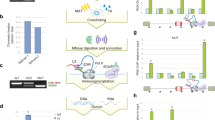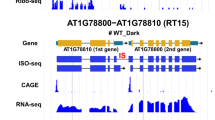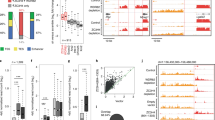Abstract
Alternative splicing is a key factor contributing to genetic diversity and evolution1. Intron retention, one form of alternative splicing, is common in plants2 but rare in higher eukaryotes3,4,5,6,7,8, because messenger RNAs with retained introns are subject to cellular restriction at the level of cytoplasmic export and expression9,10. Often, retention of internal introns restricts the export of these mRNAs and makes them the targets for degradation by the cellular nonsense-mediated decay machinery if they contain premature stop codons11,12. In fact, many of the database entries for complementary DNAs with retained introns represent them as artefacts that would not affect the proteome11. Retroviruses are important model systems in studies of regulation of RNAs with retained introns, because their genomic and mRNAs contain one or more unspliced introns10. For example, Mason–Pfizer monkey virus overcomes cellular restrictions by using a cis-acting RNA element known as the constitutive transport element (CTE)13. The CTE interacts directly with the Tap protein (also known as nuclear RNA export factor 1, encoded by NXF1), which is thought to be a principal export receptor for cellular mRNA14, leading to the hypothesis that cellular mRNAs with retained introns use cellular CTE equivalents to overcome restrictions to their expression10. Here we show that the Tap gene contains a functional CTE in its alternatively spliced intron 10. Tap mRNA containing this intron is exported to the cytoplasm and is present in polyribosomes. A small Tap protein is encoded by this mRNA and can be detected in human and monkey cells. Our results indicate that Tap regulates expression of its own intron-containing RNA through a CTE-mediated mechanism. Thus, CTEs are likely to be important elements that facilitate efficient expression of mammalian mRNAs with retained introns.
This is a preview of subscription content, access via your institution
Access options
Subscribe to this journal
Receive 51 print issues and online access
$199.00 per year
only $3.90 per issue
Buy this article
- Purchase on Springer Link
- Instant access to full article PDF
Prices may be subject to local taxes which are calculated during checkout




Similar content being viewed by others
References
Kreahling, J. & Graveley, B. R. The origins and implications of Aluternative splicing. Trends Genet. 20, 1–4 (2004)
Ner-Gaon, H. et al. Intron retention is a major phenomenon in alternative splicing in Arabidopsis. Plant J. 39, 877–885 (2004)
Galante, P. A., Sakabe, N. J., Kirschbaum-Slager, N. & de Souza, S. J. Detection and evaluation of intron retention events in the human transcriptome. RNA 10, 757–765 (2004)
Ohler, U., Shomron, N. & Burge, C. B. Recognition of unknown conserved alternatively spliced exons. PLoS Comput. Biol. 1, 113–122 (2005)
Forrest, S. T., Barringhaus, K. G., Perlegas, D., Hammarskjöld, M. L. & McNamara, C. A. Intron retention generates a novel Id3 isoform that inhibits vascular lesion formation. J. Biol. Chem. 279, 32897–32903 (2004)
Azios, N. G., Romero, F. J., Denton, M. C., Doherty, J. K. & Clinton, G. M. Expression of herstatin, an autoinhibitor of HER-2/neu, inhibits transactivation of HER-3 by HER-2 and blocks EGF activation of the EGF receptor. Oncogene 20, 5199–5209 (2001)
Bouillet, P. et al. Gene structure, alternative splicing, and chromosomal localization of pro-apoptotic Bcl-2 relative Bim. Mamm. Genome 12, 163–168 (2001)
Hiller, M., Huse, K., Platzer, M. & Backofen, R. Non-EST based prediction of exon skipping and intron retention events using Pfam information. Nucleic Acids Res. 33, 5611–5621 (2005)
Chang, D. D. & Sharp, P. A. Messenger RNA transport and HIV rev regulation. Science 249, 614–615 (1990)
Hammarskjöld, M.-L. Constitutive transport element-mediated nuclear export. Curr. Top. Microbiol. Immunol. 259, 77–93 (2001)
Hillman, R. T., Green, R. E. & Brenner, S. E. An unappreciated role for RNA surveillance. Genome Biol. 5, R8 (2004)
Lejeune, F. & Maquat, L. E. Mechanistic links between nonsense-mediated mRNA decay and pre-mRNA splicing in mammalian cells. Curr. Opin. Cell Biol. 17, 309–315 (2005)
Bray, M. et al. A small element from the Mason–Pfizer monkey virus genome makes human immunodeficiency virus type 1 expression and replication Rev-independent. Proc. Natl Acad. Sci. USA 91, 1256–1260 (1994)
Gruter, P. et al. TAP, the human homolog of Mex67p, mediates CTE-dependent RNA export from the nucleus. Mol. Cell 1, 649–659 (1998)
Sasaki, M. et al. Molecular cloning and functional characterization of mouse Nxf family gene products. Genomics 85, 641–653 (2005)
Herold, A., Klymenko, T. & Izaurralde, E. NXF1/p15 heterodimers are essential for mRNA nuclear export in Drosophila. RNA 7, 1768–1780 (2001)
Zuker, M. Mfold web server for nucleic acid folding and hybridization prediction. Nucleic Acids Res. 31, 3406–3415 (2003)
Ernst, R. K., Bray, M., Rekosh, D. & Hammarskjöld, M. L. Secondary structure and mutational analysis of the Mason–Pfizer monkey virus RNA constitutive transport element. RNA 3, 210–222 (1997)
Coyle, J. H. et al. Sam68 enhances the cytoplasmic utilization of intron-containing RNA and is functionally regulated by the nuclear kinase Sik/BRK. Mol. Cell Biol. 23, 92–103 (2003)
Jin, L., Guzik, B. W., Bor, Y. C., Rekosh, D. & Hammarskjöld, M. L. Tap and NXT promote translation of unspliced mRNA. Genes Dev. 17, 3075–3086 (2003)
Pasquinelli, A. E. et al. The constitutive transport element (CTE) of Mason–Pfizer monkey virus (MPMV) accesses a cellular mRNA export pathway. EMBO J. 16, 7500–7510 (1997)
Guzik, B. W. et al. NXT1 (p15) is a crucial cellular cofactor in TAP-dependent export of intron-containing RNA in mammalian cells. Mol. Cell Biol. 21, 2545–2554 (2001)
Hammarskjold, M. L. et al. Regulation of human immunodeficiency virus env expression by the rev gene product. J. Virol. 63, 1959–1966 (1989)
Pollard, V. W. & Malim, M. H. The HIV-1 Rev protein. Annu. Rev. Microbiol. 52, 491–532 (1998)
Kang, Y., Bogerd, H. P., Yang, J. & Cullen, B. R. Analysis of the RNA binding specificity of the human tap protein, a constitutive transport element-specific nuclear RNA export factor. Virology 262, 200–209 (1999)
Ule, J., Jensen, K., Mele, A. & Darnell, R. B. CLIP: a method for identifying protein–RNA interaction sites in living cells. Methods 37, 376–386 (2005)
Keene, J. D. & Lager, P. J. Post-transcriptional operons and regulons co-ordinating gene expression. Chromosome Res. 13, 327–337 (2005)
Wehrly, K. & Chesebro, B. p24 antigen capture assay for quantification of human immunodeficiency virus using readily available inexpensive reagents. Methods 12, 288–293 (1997)
Bor, Y. et al. The Wilms' tumor 1 (WT1) gene (+ KTS isoform) functions with a CTE to enhance translation from an unspliced RNA with a retained intron. Genes Dev. 20, 1597–1608 (2006)
Bor, Y.-c., Swartz, J., Li, Y., Coyle, J., Rekosh, D. & Hammarskjöld, M.-L. Northern blot analysis of mRNA from mammalian polyribosomes. Nature Protocols doi:10.1038/nprot.2006.216 (2006).
Acknowledgements
We thank J. Morgenegg and F.-F. Chen for technical support, and J. Swartz, A. Ward and S. Raman for comments on the manuscript. This work was supported by grants from the National Institutes of Health (to M.-L.H. and to D.R.). Salary support for M.-L.H. and D.R. was provided by the Charles H. Ross Jr and Myles H. Thaler Endowments at the University of Virginia. Author Contributions Y.L. and Y.-c.B. contributed equally to this work.
Author information
Authors and Affiliations
Corresponding author
Ethics declarations
Competing interests
Reprints and permissions information is available at www.nature.com/reprints. The authors declare no competing financial interests.
Supplementary information
Supplementary Figure 1
Alignment of tap-CTE, MPMV-CTE, and mouse nxf1 gene on chromosome 19. (PDF 322 kb)
Supplementary Figure 2
Expression of p24 in supernatants from transfected 293T cells. (PDF 123 kb)
Supplementary Figure 3
Sucrose gradient analysis of Tap mRNA from 293T cells in the presence of 15 mM EDTA. (PDF 243 kb)
Supplementary Notes
This file contains Supplementary Methods and Supplementary Figure Legends. (DOC 36 kb)
Rights and permissions
About this article
Cite this article
Li, Y., Bor, Yc., Misawa, Y. et al. An intron with a constitutive transport element is retained in a Tap messenger RNA. Nature 443, 234–237 (2006). https://doi.org/10.1038/nature05107
Received:
Accepted:
Issue Date:
DOI: https://doi.org/10.1038/nature05107
This article is cited by
-
Nuclear mRNA decay: regulatory networks that control gene expression
Nature Reviews Genetics (2024)
-
Differential fates of introns in gene expression due to global alternative splicing
Human Genetics (2022)
-
SpliceV: analysis and publication quality printing of linear and circular RNA splicing, expression and regulation
BMC Bioinformatics (2019)
-
Regulation of CHD2 expression by the Chaserr long noncoding RNA gene is essential for viability
Nature Communications (2019)
-
A novel retroviral vector system to analyze expression from mRNA with retained introns using fluorescent proteins and flow cytometry
Scientific Reports (2019)
Comments
By submitting a comment you agree to abide by our Terms and Community Guidelines. If you find something abusive or that does not comply with our terms or guidelines please flag it as inappropriate.



